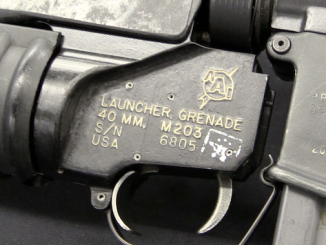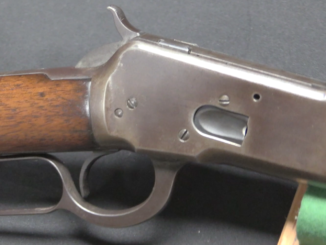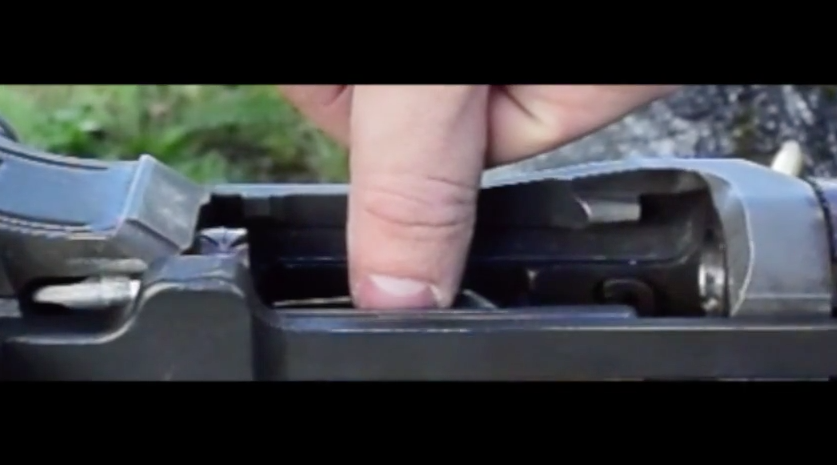Laser Products Corporation got its start in 1979, with a laser sight mounted atop a Colt Trooper .357 Magnum revolver. Shortly thereafter they introduced a range of other small arms with lasers fitted, including the Mini-14, Remington 870, and AR-15/M16. The whole line was intended for police use, as a way to aim the weapons in the dark. The lasers were large helium-neon gas tubes with rechargeable batteries. The LAPD did acquire Remington 870 shotguns with Laser Products laser sights for the 1984 Olympic Games security, and the laser also made an appearance in the movie Terminator (1984). These two things helped raise the status of the company, and they would go on to become Surefire, still around today in the same industry. Total production of the LPC Model 16, however, appears to be not more than a few dozen units. They were made in cooperation with Colt, as the upper receiver was modified substantially to fit the (factory-zeroed) laser assembly.
Related Articles

Grenade Launcher
M203 Underbarrel Grenade Launcher
After the problems with the Colt XM-148 under barrel grenade launcher were discovered in service in Vietnam, the US military was eager to quickly find a better alternative. The idea of replacing the standalone M79 […]

Lever Action Rifles
Winchester Lever Action Development: Model 1892
Rifle Carbine As the Model 1873 began to show its age, Winchester wanted a new rifle to take its place in the company catalog. Scaling down the Model 1886 to the pistol cartridges of the […]

Semiauto Rifles
M1 Thumb in Slow Motion (Ouch!)
(Note: not for the mildly squeamish) A blog reader on Reddit named Oelund sent me this footage, of him deliberately inflicting M1 Thumb on himself at 1200 fps (twice!). I figured that ought to be […]

I have the bad feeling about some cop playing “laser tag” with this item. Getting tagged means getting shot if some drunk idiot fails to cease and desist. I could be wrong.
Yeah, you’re wrong.
Given IR LASERs are now in standard use for law enforcement when using NVGs, I feel your concerns are misplaced.
Fascinating as always…Wow! Talk about progress!!
I wonder what range they are zeroed for?
They were strictly a short-range rifle for fighting in some one’s house or some one’s backyard.
You only use a laser sight if the intended target is within close proximity such that you don’t need to make calculus-based Newtonian trajectory equations. In other words, point and shoot in an alley fight.
I actually got a look at the Mini 14 version in about 82/83.
Batteries were in the stock, laser under the Barrel, small pressure pad just to the ?right of the trigger.
It was way heavier than a normal mini14, and the laser wasn’t particularly easy to see indoors.
It was also about five or six times the price of an unadorned Mini 14
It was a far cry from the present day solid state laser pointers that can pop balloons set fire to paper, and cost a few £££.
A gun is probably not the best place for a very precisely made gas tube with a multi thousand volt power supply, to survive.
I suppose that we do still use vacuum tube image intensifiers on top of guns, with kilo-volts across the intensifier tubes.
Ni-Cd batteries
There’s a distant memory
There were all sorts of rituals for preventing them from developing a “memory “, and for how to restore them when they wouldn’t hold charge.
They had a similar gist to some of the rona restrictions and when to wear a mask rituals.
My memory of NiCads is that as long as you fully discharged them before recharging, they would last a long long time. It was recharging without a full discharge which reinforced that partial level as the new base. I had a NiCad shaver which lasted 15 or 20 years.
Presumably it might be revived by discharging through a resistor a few times. But it’s been too long since I had any NiCad batteries to remember the details.
This is so called memory effect – myth by some accounts?
It should be relatively easy to 3D-print a battery case/adapter which allows the use of common batteries. But it is obviously only worth the effort if you own the gun…
Neat! I found out about the ad a week ago and was wondering if Ian would find an example.
First time I saw them in a movie was The Osterman Weekend
Also Cobra starring Sylvester Stallone. That one was a different brand, I believe, and was on a Jati-matic 9mm SMG.
cheers
eon
Interestingly Laser Products Corporation‘s product can be seen mounted to M16A1 in Transporter (2002) http://www.imfdb.org/wiki/Transporter,_The#M16A1
To my knowledge it was filmed in France (more precisely Côte d’Azur) which spawn question if that prop was used in any other French movie?
I wish videogames set in the cold war era did some actual research.
Because this is the sort of thing it would be nice to customize your guns with, within the games. But instead, they choose to add modern-day accessories (albeit stylized to look oldschool)… laser devices way too small, too many optics…